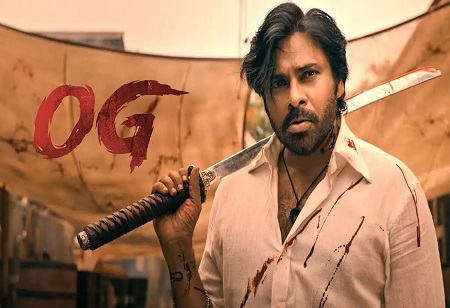OG: Visual Fireworks With No Emotional Backbone
The interval block in OG cuts between Nashik and Mumbai is such a great way. The transitions, sounds, cuts and dialogue are etched out so well. However, unfortunately, the effort that went into writing the mass sequences is not present in any other aspect of the film.
Sujeeth's visual sense is second to none. His ideas, visuals and framing of Pawan Kalyan are off the charts. Be it his intro, the interval block, the police station sequence or the climax, it's just pure fan service. But does the film offer anything else? Sadly, no.
It's pretty sad to see how these tent pole films have become so cliché—A hero with a violent past who leaves his warfare behind for his family, comes back into the game once his loved one is killed, an antagonist who deals with drugs, guns and explosives and an impact-less emotional track that’s placed for the sake of it, random mass sequences and exciting elevation blocks. This is all that OG is about.
The drama is a complete let down and you don't really feel for anyone in this film. The stakes are low and the reasons seem lame for most incidents to take place. While the action blocks and mass sequences work largely, after a point, you’re tired of it. If the movie's arc had to be defined in a line, it went from native gangsters hyping up Ojas Ghambeera to a group of Asians hyping him.
Pawan Kalyan as OG is such a great to watch. His screen presence throughout the film explains his stardom. His mannerisms, costumes, and accessories—the Katana, bracelet with Chinese transcript, high top leather boots, double shirts and jackets, along with the coolers that come off every time a shot of fire blazes in his eyes. He carries himself well and exudes aura in almost every frame. When you think it cant get better than this, you have Thaman, literally creating a firestorm. The man is firing all cylinders as he shoulders this film with an adrenaline-pumping background score, especially the interval block.
The most interesting part of the film is the Japanese angle that works in parts. On paper, it feels like a great idea. For instance, the idea of Yakuza and Samurai against each other, the way OG is linked to this world and the constant call-backs it has are great. But yet again, it lacks depth. You have so many questions and obviously, the answer to that is part 2.
The idea of a sequel/prequel or a universe is the next big trend, and OG jumps on this train as well. The sequence where this film links with Saaho almost feels unwanted. But here we are yet again to make sure we have our audience clap and whistle every 10 minutes and there is no denying the fact it works.
Also Read: Kiss: Sweet Like a Peck, But Never Truly Passionate
Despite the theater-worthy moments, it only makes you think about where these tent-pole films are heading. Has the audience's attention span really reduced? Are films going to be made with a mindset that they should work on reels? I am afraid it is, and it’s not healthy. Here is wishing a new template to take over soon and Sujeeth works on his writing as he has a universe in the making!
Verdict: OG dazzles with visuals, Pawan Kalyan’s aura, and Thaman’s firecracker score, but falters in writing, drama, and emotional depth, relying too heavily on fan service and clichés.
🍪 Do you like Cookies?
We use cookies to ensure you get the best experience on our website. Read more...






